Quality Assurance vs Quality Control: The Ultimate Guide
Find out the difference between quality assurance and quality control.
Every successful business owner understands the crucial role that quality plays in defining the success of their product or service.
Ensuring high quality is not just about producing excellent goods or services, it involves two critical procedures - Quality Assurance (QA) and Quality Control (QC).
According to Testlio, about 67% cite bad user experiences as the primary reason for customer churn.
But what are these two concepts, and how do they differ from each other? The distinction between these two methods can be quite blurred, but their understanding and effective implementation are pivotal to any business that aims for sustainable growth and a quality customer experience.
This article aims to provide an ultimate guide on QA and QC, their uses, similarities, and differences.
What Is Quality Assurance?
Quality Assurance (QA) is a strategic approach aimed at preventing defects or issues before they occur. It's a proactive process that involves designing and implementing a systematic set of activities to ensure that the product or service being developed meets specified requirements.
In simple terms, quality assurance is all about planning and establishing processes related to quality.
QA is a broad concept that encompasses the entire product development cycle. It includes steps like defining standards, creating guidelines, and conducting audits to ensure that the defined procedures are being followed.
The main goal is to establish an environment where the output quality is consistently high and any potential problems are caught before they arise.
How is Quality Assurance Used?
QA is utilized to instill a level of confidence that the product or service will meet the defined quality standards. It is used for ensuring that the processes used in production are effective and efficient.
If applied correctly, QA helps businesses to prevent mistakes or avoid problems (misroutes) when delivering solutions or services to customers.
Furthermore, quality assurance is essential for fostering a quality culture within an organization. It reinforces the idea that everyone in the organization is responsible for quality, not just the testing or quality department.
It helps to build customer trust and credibility, enhancing the reputation of the business.
Join thousands of teams who are using Text Blaze templates.
Why is Quality Assurance Important?
Quality Assurance (QA) is crucial as it prevents issues before they occur, saving resources and preserving a company's reputation. It provides consistency by establishing systematic procedures and standards, ensuring all outputs maintain a uniform level of quality, which boosts customer satisfaction and loyalty.
Moreover, QA fosters a culture of quality within an organization, making everyone responsible for maintaining quality standards. This enhancement of an organization's culture leads to increased overall productivity and profitability.
What Is Quality Control?
On the other hand, Quality Control (QC) is a reactive process. It involves identifying and correcting defects in the finished product, ensuring that the final output meets the specified quality standards.
QC is focused on product-oriented activities; it tests and checks the actual products to verify whether they meet the required specifications or not.
Quality Control involves activities like inspection, examination, testing, and sampling of goods or services. Unlike QA, which is process-oriented, QC is product-oriented. It identifies any errors or faults in the final product, so they can be rectified before reaching the customer.
How is Quality Control Used?
Quality Control is primarily used to identify defects after a product or service is developed and before it's released. Its main focus is to identify and fix defects in finished products, thereby improving the quality of outputs.
Furthermore, QC helps in maintaining product consistency, allowing businesses to deliver a consistent level of service or products to their customers. It also provides a basis for continual improvement as it offers opportunities to learn from errors and prevent their recurrence.
Join thousands of teams who are using Text Blaze templates.
Why is Quality Control Important?
Quality Control (QC) is vital as it identifies and rectifies defects in the final product, maintaining customer trust and protecting the business's reputation.
Quality control ensures a consistent level of quality across all products, fostering customer loyalty and improving the customer experience.
QC also promotes continuous improvement by allowing businesses to identify and investigate product flaws, leading to informed changes in production processes.
Plus, by detecting defects early on, QC helps businesses avoid costs related to faulty products, positively affecting the company's bottom line.
QA vs QC: Similarities
While Quality Assurance and Quality Control are distinct in their focus, they share a common goal – to deliver a high-quality end product.
Both processes are essential components of an effective quality management system, and they work best when used in conjunction.
Another similarity is that both processes involve staff training, detailed documentation, and the use of testing methodologies. Both QA and QC require clear communication and thorough record-keeping to ensure that all procedures are carried out correctly.
Ultimately, effective quality assurance and quality control can improve customer experience and boost employee accountability.
QA vs QC: Differences
Despite their similarities, QA and QC differ in their approach towards ensuring quality.
Quality Assurance is a proactive process focusing on error prevention, whereas Quality Control is a reactive process focused on error detection.
QA is process-oriented and helps in establishing necessary procedures and standards to prevent defects, while QC is product-oriented and helps in identifying and rectifying defects in the finished products.
In essence, QA makes sure you are doing the right things, the right way, and QC makes sure the results of what you've done are what you expected.
How to Automate Quality Assurance & Quality Control

Quality assurance and quality control are both very important practices that can have a huge impact on your business.
If you are looking for a way to streamline your QA and QC, give Text Blaze a try. Text Blaze allows you to use keyboard shortcuts to insert smart text templates anywhere you work online.
Text Blaze helps you streamline your workflows, automate repetitive typing, and ensure your team gets the right message every time.
With Text Blaze, you can:
- Boost QA & QC with automated response templates for any situation.
- Create SOPs & decision trees to improve team decision-making and communication.
- Streamline workflows and boost productivity with high-quality templates.
- Customize your templates with forms (placeholders) so you don't lose your personal touch.
This template is an example of how customer support teams can use Text Blaze to create SOPs to aid in decision-making for addressing customer issues.
Did the live troubleshooting call resolve the issue? {formmenu: ; no; yes; name=q4} {endif}{if: q1=yes and q2=yes and q3=no and q4=yes} {error: Next steps: close the ticket}{elseif: q1=yes and q2=yes and q3=no and q4=no} {error: Next steps: escalate request to Tier 2 team by placing it in their ticket queue}{endif}{endnote}
Join thousands of teams who are using Text Blaze templates.
QA & QC as Tools for Businesses
Understanding and implementing Quality Assurance and Quality Control in your business can make a significant difference in the overall quality of your products or services.
While QA focuses on preventing defects through the use of proper procedures and processes, QC ensures that the final product is free from defects and meets your quality standards.
Both are crucial for building a successful and sustainable business.
Use Text Blaze to streamline your workflows, ensure effective QA & QC, and make sure your team gets the right message every time.




